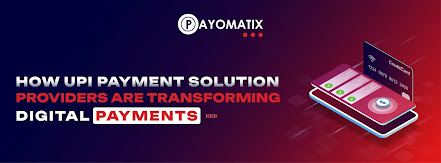UPI Intent: Revolutionizing Digital Payments for Businesses in 2025
In the rapidly evolving digital payment landscape, businesses must stay abreast of innovations that enhance transaction efficiency and customer satisfaction. One such advancement is UPI Intent, a feature of the Unified Payments Interface (UPI) system that is transforming payment processes in 2025.
For more insights into digital payment solutions, visit Payomatix.
What Is UPI Intent?
UPI Intent streamlines digital transactions by eliminating manual payment inputs. It enables seamless integration between payment apps and merchant platforms, utilizing deep linking technology to ensure a smooth payment flow.Key Features of UPI Intent:
- Frictionless Payments: Automatically populates payment details, reducing errors and transaction time.
- Enhanced Security: Minimizes risks associated with manual entry, such as phishing or incorrect details.
- Cross-Platform Compatibility: Operates seamlessly across mobile applications, making it versatile for both businesses and consumers.
How UPI Intent Works?
When a user initiates a transaction on a merchant platform, UPI Intent redirects them to their preferred UPI app with pre-filled payment details. After authentication, the payment is processed instantly, enhancing user experience and reducing cart abandonment rates.Advantages of UPI Intent for Businesses:
- Improved Checkout Experience: A smoother and faster payment process leads to higher conversion rates, especially in e-commerce.
- Cost Efficiency: UPI payments are generally low-cost compared to traditional payment gateways, making them ideal for businesses of all sizes.
- Real-Time Settlements: Instant payment processing reduces cash flow delays, enabling businesses to manage finances more effectively.
- Wider Reach: UPI’s popularity in India ensures a broad customer base, giving businesses an edge in penetrating diverse markets.
UPI vs. Traditional Payment Methods:
- Speed and Convenience:
- UPI Intent: Payments are processed in seconds, providing instant confirmation.
- Traditional Methods: Transactions like NEFT or RTGS may take hours or even days, leading to delays.
- Security:
- UPI Intent: App-based authentication ensures robust security, reducing the chances of fraud.
- Traditional Methods: While generally secure, traditional methods can be vulnerable to phishing or card skimming.
- Cost Efficiency:
- UPI Intent: Minimal to zero processing fees make it an attractive option for businesses.
- Traditional Methods: High processing fees for cards and payment gateways can add up over time.
- Customer Experience:
- UPI Intent: Offers a user-friendly interface and supports various use cases like P2P transfers and bill payments.
- Traditional Methods: Often require manual inputs, which can lead to errors and frustration.
Implementing UPI Intent in Your Business
To leverage UPI Intent effectively:
- Seamless Integration: Ensure UPI Intent is integrated into your payment system to provide a smooth experience for customers.
- Educate Your Audience: Use marketing campaigns to inform customers about the safety and convenience of UPI Intent.
- Leverage Data Analytics: Use transaction data to gain insights into customer behavior and refine your payment strategy.
- Expand Use Cases: Explore various applications of UPI Intent, such as bill payments and peer-to-peer transfers, to enhance customer engagement.
For more insights into digital payment solutions, visit Payomatix.




Comments
Post a Comment